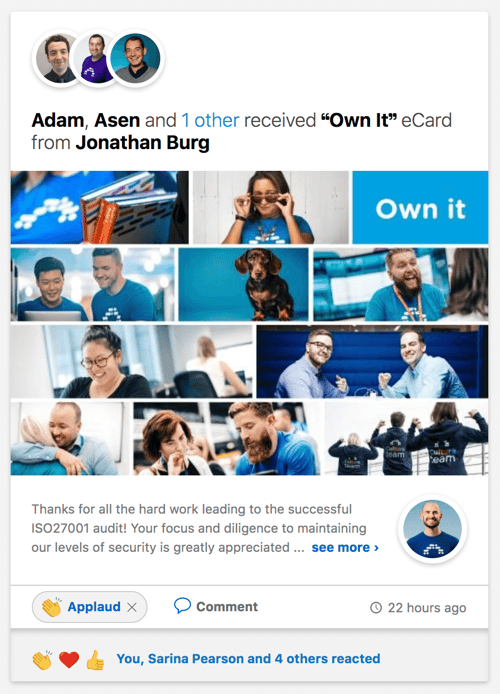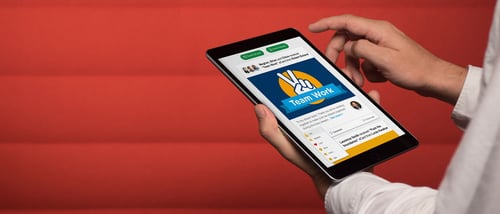It’s no surprise: Employee motivation is critical to employee engagement. It leads to better business results and a more consistent customer experience – it’s something all leaders want for their organizations.
The question then becomes: Why aren’t more companies leading the way in motivating their people?
Recognizing employees and creating the environment for motivation can feel complicated or time-consuming, but in reality, it’s easier than you think. By focusing on three core areas of respect, purpose and relationships, leaders can have a true impact on their people and their business. Technology can help fuel this environment, too.
Let’s go through how to create a culture of appreciation with technology and combat demotivators in the workplace.

Shine a spotlight on a behind-the-scenes team by showing respect
Picture this: You have a hard-working IT team that has tirelessly been working behind the scenes to update language on your technology to meet new security requirements.
They’re required to work with tons of stakeholders in the business to update processes and the copy within the tech, and they’ve been met with terse responses, or worse, been blown off completely. Because of the lack of urgency on the company’s part, the team has tried to fast-track requirements and are at risk of failing the next security audit.
The team’s manager uses a strategic recognition program to share stories of how hard his team is working and to highlight the long-term impacts to the business to bring everyone closer together and improve employee motivation.
Sharing these recognitions in meetings and online motivates not only the team, but also gains external support to help the company meet its deadline.
At Reward Gateway, we’re focused on providing the most secure experience for our clients. We recently celebrated passing our ISO27001 audit, so this is a story that hits a little closer to home. When others in the business (no matter the location) visit our social recognition wall and read peer-to-peer recognitions, they’re not only more informed but can comment and react with an emoji – adding to the celebration and excitement around a win for the company.

Sharing recognitions across departments can build this understanding, boost collaboration and remove the “us vs. them” mentality that can destroy your employee experience. It’s key to look for opportunities to recognize not just highly great work, but great work behind the scenes.
This will help with team-building and rewarding employees without favoritism. Ask yourself, who do you know who does great work for the company but may be overlooked for recognition?
Download our eBook to discover how an employee rewards system can help improve employee motivation »
Connect high-turnover teams to individual and company purpose
Let’s take a look at another common situation, where we see teams with high turnover — maybe there’s a high pool of entry-level employees, or management shifts often — who have gotten a reputation for clocking in and doing their job… but not much more than that.
By concentrating on the behaviors you want to see from the employees who are already going above and beyond, you can drive the values-based behavior you want to see, and that your business needs to succeed.
In this case, the team’s manager can link up communications and recognition to shine a big spotlight on what the team is doing, why it matters and how they can do more of it with a centralized employee engagement platform.
Here’s an example of a motivational, strategic post that gets core retail team members through Black Friday. How? Once that message is out there, that’s just step one. Follow up by asking team members to share stories of when they or others did the actions mentioned in the blog, or if they can think of other examples where they lived the value.

Side note: Managers are so important here – they’re a big part of encouraging teams to share stories, and participating! Kick this up a notch and train managers to recognize employees to improve morale.
Managers should be prepared to share something they noticed (checking with the team first that it’s OK to share!). With enough of a spotlight, the Retail Team will see how others on their team have made an effort to put best practice in action, and deliver a consistently great experience.
Managers can take it a step further, and consider nominating some of these team members for a special Employee of the Month award, connected to that particular value. Employees are happy, customers are happy and the business benefits. What could be better?

Increase collaboration among larger teams
The last example we’ll share is about relationships, specifically for connecting dispersed employees, improving relationships among larger teams or communicating with offline workers. One situation I see a lot are teams that overlap in duties — maybe that’s nurses, or retail employees or food service, for instance.
At the end of a night shift at the hospital, your employees are likely exhausted. The last thing they want to do is admin work, like tidy up notes from the latest patient round. But it's all critical to how a business operates.
And if those actions don’t get done, then it’s up to the next team that walks into the door to take care of what was left behind, on top of their job. Lack of attention to how your actions impact others can build resentment and disengagement. And let’s not forget, it also takes attention away from serving clients (or patients) and bringing in profit for the organization. So how can you fix it?
While there were specific tasks that needed to be done, in this case managers can see beyond the individual to understand that there must be a change in the team mentality. By shifting the focus to the positive, you can start to break down a negative environment.
Managers can lead by example, and teach team members how to recognize the great work around them rather than just focusing on the end of the night.

The important part of all of this is to make sure that the action is widely shared through public means, either through Post-it notes tacked on to the break room wall, or a digital social recognition wall that employees can access anywhere, anytime.
As the relationships improve among team members, the staff can focus on larger initiatives instead of narrowly focusing on nitpicking their team members on opposing shifts.
For healthcare organizations, that might mean more time spent on gathering patient feedback to understand how employee engagement impacts your business. And if employees are more understanding of their goals and how their actions impact the business, it’s likely to lead to an increase in employee retention in healthcare.
It’s key to choose technology that helps you connect with your employees, improve employee motivation and create a culture of appreciation. Unsurprisingly, the more motivated and engaged your workforce is, the better your business results and the happier your customers will be. What next step will you take towards improving employee motivation and retention at your organization?

%20(1).jpeg) Alexandra Powell
Alexandra Powell
